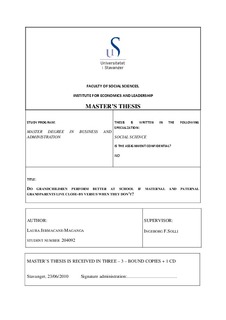| dc.contributor.author | Jermacane-Maganga, Laura | |
| dc.date.accessioned | 2011-01-24T09:37:09Z | |
| dc.date.available | 2011-01-24T09:37:09Z | |
| dc.date.issued | 2010 | |
| dc.identifier.uri | http://hdl.handle.net/11250/183807 | |
| dc.description | Master's thesis in Social economy | en_US |
| dc.description.abstract | This study investigates whether grandchildren from intact families perform better at school when their maternal and paternal grandparents live close-by versus when they don’t. The answer to this question is based on assumption that geographic proximity measures grandparental participation in grandchildren’s lives therefore influencing their outcomes which are measured as Grade Point Average in 10th grade. Relevant theories are presented like resource allocation and mandate attribution in a family system, direct and indirect processes through which grandparents are able to influence their grandchildren, in combination with available previous research studies.
A unique database was available in order to enable to provide an answer to the research question applying a quantitative research design by using analytical program Stata on 151 092 Norwegian grandchildren 12 years of age. The results generated by Ordinary Least Squared Regression analyses show that, there is no difference how well a grandchild performs at school considering maternal and paternal grandparents’ proximity level because estimates obtained for this association is essentially statistically significant zero. Parents’ educational level is the decisive element in choice of proximity in relation to grandparents.
It is also noted that intact families living in close proximity to grandparents tend to possess less resources available within a family compared to the ones living further away indicated by lower earnings, higher proportion of parents receiving social benefits, higher proportion of parents with primary or secondary education. This selection bias in the sample might be a cause of not finding the expected association of geographic distance and Grade Point Average of grandchildren.
Proximity variable is also discussed in terms of its appropriateness to measure the intended association of interest since there might be implications that it is the relationship quality and not the contact frequency which allows for greater direct influence on grandchildren’s performance at school. Alternatively, possibility that an important parents’ related control variable is not accounted for in the model of the study is presented. The inconsistency of the results of conducted sub-sample analyses might reinforce to support the last two statements.
The results of this study cannot be generalized to all grandparents and grandchildren, since the analytical sample consisted only of grandchildren raised in intact families with several other restrictions imposed. | en_US |
| dc.language.iso | eng | en_US |
| dc.publisher | University of Stavanger, Norway | en_US |
| dc.relation.ispartofseries | Masteroppgave/UIS-SV-IØL/2010; | |
| dc.subject | økonomi | en_US |
| dc.subject | administrasjon | en_US |
| dc.subject | samfunnsøkonomi | en_US |
| dc.title | Do grandchildren perform better at school if maternal and paternal grandparents live close-by versus when they don’t? | en_US |
| dc.type | Master thesis | en_US |
| dc.subject.nsi | VDP::Social science: 200::Economics: 210::Economics: 212 | en_US |
| dc.source.pagenumber | 103 p. | en_US |
